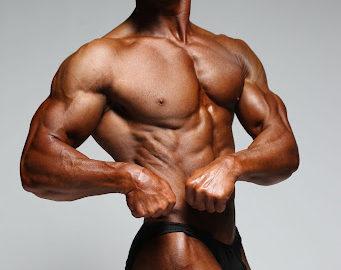Behind-the-neck exercises—pulldowns, pullups and presses—are often believed to be more effective than the same exercise performed to the front, but some movements can be dangerous. Pulldowns and pullups behind the neck are less risky than behind-the-neck presses, but they can be problematic too.
Many powerlifters and noncompetitive strongmen have popularized behind-the-neck presses. The bar travels a shorter distance than it does during military presses. The behind-the-neck press requires more shoulder range of motion, however. It requires external rotation of the shoulder—so you can get the bar behind your head—and scapular retraction, which is pulling your shoulders back. If your pecs are tight, your shoulders will be rounded forward to varying degrees. The tightness will limit your ability to externally rotate your shoulders and also limit your ability to retract your shoulder blades. Those limits can produce shoulder pain from an exces-sive strain on the rotator cuff tendons or bursitis under the roof of the shoulder.
A more serious injury that I have seen with this exercise more than any other move is disk protrusion, or herniation, in the neck. The trapezius muscles contract very strongly in the behind-the-neck press. The heavy weight being pushed overhead behind the neck, plus the powerful trap contractions, can make you susceptible to disk injury. While it’s uncommon in weight training, I see it the most with this exercise. If you already have neck problems, I strongly recommend that you avoid behind-the-neck presses. Even though the traps contract powerfully on shrug and military presses, the cervical-spine-disk-injury rate does not appear to be as prevalent.
The behind-the-neck press targets the deltoids, trapezius, serratus anterior, triceps and a little biceps brachii. It’s been used and liked by many people over the decades. Many powerlifting champions liked and used it, while others felt they were too tight to use it.
The first person to break the 700-pound bench press barrier was Ted Arcidi, who used 400 pounds on the behind-the-neck press. Ed Coan performed the same amount at 217 pounds bodyweight, which must be one of the greatest shoulder-strength feats ever. David Paul, one of the Barbarian Brothers, did the same weight at 264 pounds. Famed Venice strongman Steve Merjanian did a 405-pound behind-the-neck press and a 500-pound incline press. The late Joe Gold always joked that Merjanian was the model for the gorilla on the World Gym logo. Ken Patera will forever hold the American press record at 505 pounds because the lift was dropped from the Olympic Games. Patera also performed 405 pounds in the behind-the-neck press. Former Olympic weightlifter-turned-professional wrestler Mark Henry also went over 400 pounds on the lift. With the advent of bench press shirts and the goal to limit motion, I believe the behind-the-neck press has fallen from favor in powerlifting circles at this time.
It’s a good lift, but it’s not for everyone. If you have any neck problems, either don’t use it or stop using it. If you have shoulder pain, it may help you or cause you more pain, depending on which shoulder problem you have. Strengthening the rotator cuff may enable you to perform the lift.
One last bit of advice is to not force reps. Many trainees get stuck with the bar halfway up while doing one more rep and use their neck as an accessory muscle as they strain to raise the bar. The added compression on the neck from the straining traps and neck muscles may be too much for the disk. Most such disk injuries are in the lower neck, at the C5-6 and C6-7 levels.
Always train smart first, then train hard. You will be healthier, stay in the gym and have more workouts, which will give you more gains.
Editor’s note: Visit www.SoftTissueCenter.com for reprints of Horrigan’s past Sportsmedicine columns that have appeared in IRON MAN. You can order the books Strength, Conditioning and Injury Prevention for Hockey by Joseph Horrigan, D.C., and E.J. “Doc” Kreis, D.A., and the 7-Minute Rotator Cuff Solution by Horrigan and Jerry Robinson from Home Gym Warehouse, (800) 447-0008 or at www.Home-Gym.com.




















You must be logged in to post a comment Login